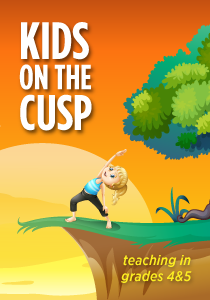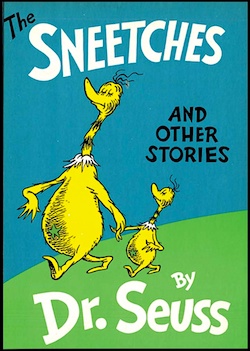What We Learned from a Star-Bellied Sneetch
A MiddleWeb Blog

I was reminded recently, and unexpectedly, of the true essence of one of his stories in particular, and of the impact it had had on me as a child when, in late November, a few characters from that story came to visit us in 4T.
It was a group of star-bellied sneetches…you know…the ones that live on the beaches. They appeared one day during the launch of our non-fiction unit.
The plan was to model (out loud) some questions I had about an animal or person with personal significance to me – a subject that I wanted to find out more about through research. What came out of my mouth was definitely not non-fiction. “When I was about your age, I was fascinated by a creature that I read about in a book. It was called the Star-Belly Sneetch.”
This drew a few chuckles from the rug, and I’m pretty sure some of the kids thought this potentially fascinating creature was, in fact, very real. Perhaps some exotic animal from a distant land. Why Star-Belly Sneetch popped into my head at that very moment, I’ll never know, but I decided to go with it.
Sneetches take over non-fiction unit
Seuss’s Sneetches followed us throughout our research. We used them to achieve many technology benchmarks: word-processing, cutting, pasting, and formatting our prose into unified paragraphs.
We used our research as a jumping off point to create our own, individual non-fiction books, adding text boxes and tables of contents. On the final day of Read Across America week, we got to share our work with our second grade buddies.
Watch the complete Sneetches story here or on YouTube (Source)
I launched the week by introducing them to Seuss’ original story, The Sneetches, first copyrighted in 1953. Throughout the week, we discussed and revisited the bigger messages embedded in the good doctor’s cautionary tale about the dangers of star-bellied sneetchery.
The kids got the same message I got when I was their age. Back then, I did not like those snotty Sneetches with the stars on their bellies, parading around the beach and acting like they were better than everybody else. I knew I never wanted to be one of those Sneetches.
My class didn’t like them very much either, and we talked about how bad their behavior was. We even shared some of our own, sneetchy moments – those days when we felt “star-less”, as well as the days when we may have acted like we had stars upon our own bellies.
Maybe this is just Social Emotional Learning, as discussed in a 2015 article in The New York Times, in its simplest form. Maybe it could be even more.
Can Sneetches take over America?
We’ve seen the powerful impact of the Grinch’s sad story. Let’s start another Seuss-inspired tradition, connecting readers and thinkers across America with a message that can transcend every learner’s circumstantial schema, a new way to reach through our minds and into our hearts. We might call it Sneetch Across America. #Sneetch
Sneetch Across America’s goal would be to help kids (and adults) get in touch with their inner Sneetch, to recognize the commonalities among Sneetches across the world, the fears and insecurities of fitting in, and the impact of privilege and belittlement, as well as the injustice of oppression.
We’ll use our brains, not our bellies, to educate ourselves, and each other, about the benefits and beauty of diversity. Different doesn’t have to mean separate…or better than.
What Sneetch across America might look like
Starting in elementary school, teachers could introduce students to Seuss’ Sneetches and the multiplicity of themes and opportunities they give us for rich discussion. We’ll need a common definition, a simple definition – one that encompasses the true essence of sneetchiness and can be adjusted to fit any grade level. How about this:
Sneetch: (noun) an individual who uses his or her physical traits, beliefs, religion, or gender as a means to see themselves as different from the community in either a positive or negative way.
Star-Bellied Sneetch: (also a noun) a Sneetch who thinks he or she is better than the other Sneetches; one who brings discord and elitism into a group with the intention of causing a hierarchical system aimed at creating schisms within the group.
Elementary school definition: Somebody who puts people into different groups and decides one group is better.
There are plenty of free resources on line that we can access (see below). These were designed by talented educators across the country. They can help us reach students from kindergarten through high school…and beyond. Maybe exposure to the same, simple life lesson year after year might evoke change, albeit slowly, and we can get those beaches cleaned up.
My inner Sneetch
Sneetches are fickle creatures. Years after first meeting Geisel’s Sneetches, I still find myself quite capable of star-bellied sneetching. Maybe Seuss’ Sneetches are back to remind me that I, too, can exhibit star-bellied sneetchery.
I can sneetch about the pressures at school or the ugliness I see each day on the news. I can find myself thinking I’m just a little better than one of the other Sneetches on the beach, the Sneetch at the grocery store, the one who leaves his cart in the middle of the aisle, unaware of the other shoppers around him or the path he is blocking. But the Sneetch in me needs to get off of her soap box…it’s blocking the aisle too.
Dr. Seuss shows us all that there’s no such thing as a perfect Sneetch. Until recently, I’d never explored the more intimate details of his life, or his opinions and actions outside of Seussville, as discussed in Gabriel Smith’s It’s Time to Talk About Dr. Seuss. To me, he was simply the creator of a magical world filled with poetic life lessons, seasoned with an ample dash of enchanting word play and a knack for ridiculous rhyme. As it turns out, he’s just another Sneetch on the beach.
Apologists tend to make two arguments about why this early bigotry doesn’t matter: The first is that Geisel was merely reflecting the humor of his day. The second is that his multi-decade career as Dr. Seuss would essentially make up for his early public bigotry.
With older students, you can address these arguments directly, discussing the degree to which cultural norms excuse biased language or actions, how harmful stereotypical representations can be and whether—and how—a person can make up for hurtful mistakes. And you can and should talk with them and with other educators about how we can have a deeper understanding of the ways racism shows up in places and people we’d least expect. – Gabriel Smith, Teaching Tolerance, 2019.
And at the end of Seuss’s story, nobody knows which Sneetch is which. Star-Bellied status has become a sea of confusion on those beaches, with those silly, silly Sneetches. At age eight, I understood the main idea of Geisel’s brilliantly simple story. Decades later, as an adult, the deeper, more painful ironies about Seuss’ Sneetches are much more powerful.
After reading Gabriel Smith’s article (including the section subtitled “And what about The Sneetches?”) teachers will likely see the need to talk with students in age-appropriate ways about whether being “colorblind” is enough or, whether – quoting Smith – we need to “take action against injustice.” Can we still use The Sneetches in effective ways to “teach tolerance” and justice? It’s a question any teacher who picks up the book will need to address.
Shifting focus
In recognition of Theodor Geisel, fellow Sneetch and voice of Dr. Seuss, I offer one simple request,
When you do meet a Sneetch with a star upon thars,
Or a Sneetch whose belly has none upon thars,
Look up from their belly and into their eyes,
And search for the Sneetch there, behind the disguise.
And if this poem seems a little too preachy,
Please don’t judge too harshly.
We all can be sneetchy.
Hope to see ya’ on the beach!
Sneetchery Teachery Resources

✻ Printable text of Seuss’ poem.
✻ Perspective: “Read Across America Shifts Away From Dr. Seuss and Toward Diverse Books” by Grace Hwang Lynch. School Library Journal (9/12/17).
✻ Elementary Level: Star-bellied activity from CPalms’ online toolbox modeling what it feels like to be left out.
✻ Middle Grades: The Sneetches by Oliver Pinel on Creating Function Machines.
Grades 3-8:
✻ TEACHING Children PHILOSOPHY’s guide to discussing prejudice and diversity through Seuss’ Sneetches.
✻ A contribution to Scholastic by Rhonda Stewart that offers ideas and concrete examples using close reading of The Sneetches.
Middle/Upper Grades:
✻ Fresh Plans Lessons.
More Perspective:
✻ Peggy McIntosh article White Privilege: Unpacking the Invisible Knapsack, discussing the effects of privilege from the National Seed Project.
✻ Center for Civic Reflections: Sneetches webpage with resource for exploring multiple themes on exclusion and belonging, gender and sexuality, power and privilege, and much, much more.





































I love this! I have used it as a teacher and administrator! Thanks for the inspiration.
Thanks, Patricia! I am amazed at how the same message was received decades after I was in elementary school…sneetchery certainly transcends historical timelines!